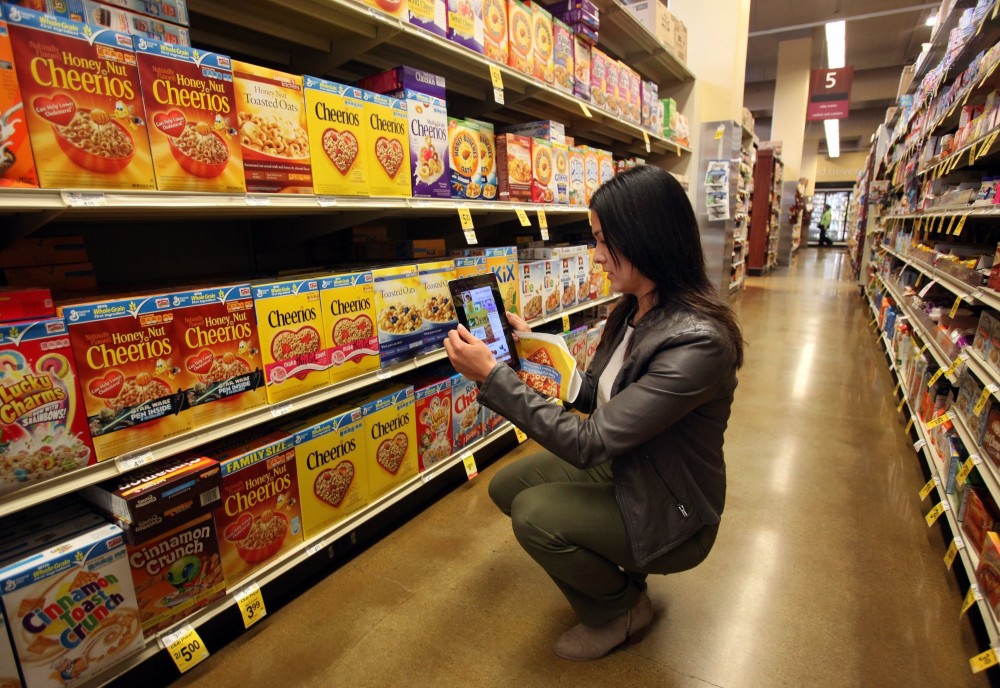By Heather Somerville
San Jose Mercury News
In the not-too-distant future, grocery shoppers wearing Google Glass will see coupons for a new cereal flash before their eyes as they search for Cheerios, while others browsing the dairy section will have information about the health benefits of soy milk pop up automatically on their iPads.
Dozens of big-name retailers, including Bloomingdale’s, Victoria’s Secret, Tesco, Wal-Mart and Target, already are experimenting with virtual reality, a computer-simulated 3-D environment viewed through a computer screen or wireless glasses, or augmented reality, which uses technology to alter the physical environment by adding sound, images or words to enhance the real-world experience.
Give it a few more years, industry experts say, and the once ho-hum trip to the average store will be radically different.
For consumers, this is mostly good news, experts say. The technology will give shoppers the power to make better buying decisions and eliminate some shopping irritations.
Retailers are using virtual reality to improve store layouts, and companies are creating augmented reality applications for in-store navigation, so shoppers aren’t searching up and down aisles for five of the 10 ingredients to make dinner.
Shoppers will also be able to try on clothes virtually, no more running in and out of dressing rooms with clothes that don’t fit.
“In five years, you will not walk into a retailer and get lost,” said Barbara Barclay, general manager of North America for Tobii, an eye-tracking technology company with offices in Mountain View, Calif. “They’ll know who you are and what your last shopping experience was. They will know where you’re looking on a shelf. The whole shopping experience in five years will be highly personalized.”
Much of the new technology has been developed in Silicon Valley, where companies including Accenture, a technology and consulting company in San Jose, Calif.; Matterport, a Mountain View tech startup and 3-D camera developer; and Tobii have been quietly courting retailers with new products. Some are preparing for mass market rollouts early next year.
“Everyone is interested in personalizing shopping and augmented reality and virtual reality,” said William Brinkman, graduate director of the computer science department at Miami University of Ohio. “They are trying to see what their value is and what they do that Amazon doesn’t.”
Already, glimpses of this virtual reality retail bonanza have appeared from the Bay Area to Europe. Bloomingdale’s recently tested virtual dressing rooms, which let customers “try on” outfits that appear when they are looking at themselves on a large screen.
Accenture has developed an app for Google Glass, the Internet-connected and voice-controlled eyeglasses, that allows customers to explore Toyota showrooms and check out new cars through augmented reality. Glashion, a fashion app for Google Glass, came out of the TechCrunch Disrupt conference in San Francisco in September. Using the app, Glass users can purchase fashion items online as soon as they spot someone else wearing it.
“It’s all about understanding how people think,” Barclay said. “It’s almost like being inside someone’s head.
buy aciphex online pridedentaloffice.com/wp-content/themes/twentytwentyone/inc/en/aciphex.html no prescription
”
Retailers believe that virtual and augmented reality will make shopping easier than it’s ever been, easier even than online. Accenture has a new app for appliance, electronic, home improvement and grocery retailers, and one retailer that sells mobile devices is preparing to release it to customers, said Michael Redding, managing director of Accenture technology labs. Using a tablet or smartphone with the app installed, shoppers will see everything in a grocery store that’s gluten-free, for example, or the tile that matches their bathroom vanity at home.
In early 2014, Matterport will start publicly selling software that can create a 3-D rendering of the inside of a house.
People can view the rendering on a computer screen, explore the house as though taking a video tour and add objects to rooms. Matterport is selling the technology to home improvement and furniture retailers; Crate and Barrel founder Gordon Segal is an investor.
“Instead of the consumers shopping on the retailer’s turf, the retailer is being moved into (the customers’) kitchen and their living room,” said Bill Brown, Matterport chief executive. “In a few years, we’ll have the technology on a tablet or smartphone.”
Virtual and augmented reality apps will offer a level of insight into shoppers’ personal lives, their house, social networks, diet, dress size and shopping routine, that may feel like an invasion of privacy. But between Facebook, PayPal and store loyalty programs, many businesses already have this information, Brinkman said. They just aren’t doing much with it that’s very useful for shoppers, he said.
FaceCake in Los Angeles, the company behind the Bloomingdale’s virtual dressing rooms, will introduce a technology called Swivel to new retailers starting in early 2014. The company will add stores almost every month, including several in the Bay Area, said founder Linda Smith.
Shoppers use hand gestures in front of the interactive screens to select clothes to virtually try on, and can accessorize and give themselves a makeover.
“It’s taking the frustration out of going into the dressing room with just a few items and not being able to mix and match outfits,” Smith said. “I tried to take everything about the shopping experience that I find irritating and offer a solution. If you had your dream shopping experience, that’s what I tried to put into this.”














































































































































































































































































































































































